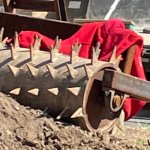Do a Google search for "frost seeding". More than several University Extension Offices should have info on it. I've used it 6+ times in the past 20 years to re-seed both pasture, and my small hayfield. Only 1 time was it not very successful, and that was 2 years ago. Temperatures did not get cold enough to honeycomb the ground to pull the seed in. Once you understand the concept, you'll understand. You're basically mimicking Mother Nature by spreading seed on the ground during that period in early Spring when the ground honeycombs during the freeze/thaw cycle. Seeds will get in the open honeycomb, and the freeze/thaw will pull the seed in, and cover it up. Here in Central Ohio, the period to do that is the last 2 weeks, of Feb., through the first 2 weeks of March. 2 years ago, with the mild winter we had, it simply did not get cold enough to do that, after I spread the seed, at least on the part I had disked up in the Fall after doing a complete burn down due to some noxious weeds I'd picked up in some hay I purchased, then spread the manure on the field. It did however work well on the part that was still in sod, and not sure why.
In May of that year, after seeing that frost seeding wasn't successful, I disked it up, and broadcast more of the same seed. This planting was successful, but didn't get much off of it the first year. However, last year I was very pleased with results.
The hay I raise is for my horses. It was sowed in Rye Grass for 15 or so years. There was simply too much waste of first cutting hay, as the Rye Grass was course and stemmy. I finally decided it was time to switch to something more palatable for them. I went with a mix of Cajun (name brand) Fescue, an endophyte free fescue, red clover, Tuukka Timothy, alfalfa, and bluegrass, and some Renovation white clover (also brand name) to put N in the ground. Too many years of spreading Urea on, just ahead of a supposed rain predicted by the National Weather Service, but never happened, so it evaporated. Happy to report, the horses are loving this hay, and eat the first cutting very well. Second cutting even
better.
I pulled soil samples last Fall to check and see if the Renovation clover was doing its job. Our Extension Agent called last week, so as to come in and talk over what amendments I'd need. With the weather we've had, haven't made it in yet, but he did tell me over the phone, the PH level is perfect N & K levels are great, just need to add a bit of phosphorous this year, how much, I don't know yet. With the price of fertilizer going off the charts this year, that is surely good news to me.
As for the frost seeding, you can always do a small section of your choice, and see if it works for you. You're not that much South of me, so with the present weather this winter so far, you could be in the prime season to do it. It doesn't take anything fancy to spread it. I use an old Seed Easy PTO spreader on my little Farmall Super C, and it does a great job. You just have to pick a day, or time of day where the wind isn't blowing hard, like it does here in March, or just wait until early evening, when the wind lays.
For a backup plan, or to sow Timothy in Sept. I use a 4' slit seeder, which does very well too. Many rental companies who rent a full line of equipment, usually rent these too. They are small, but with mine, suggested speed to plant is 7 mph., so you can cover some ground. Here, extension offices also rent no-till drills, and last I heard, charged $15 per acre to rent. Way less than buying one.

